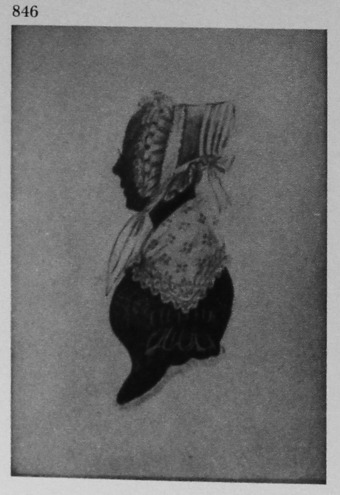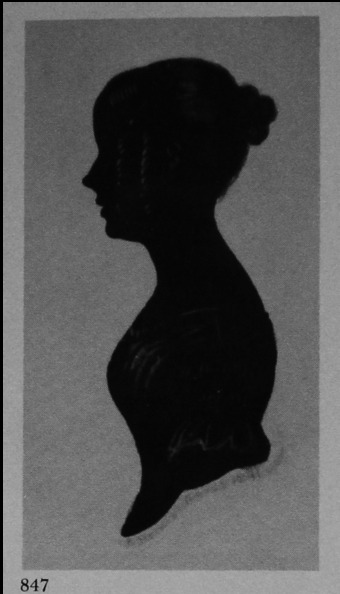Holmes, James, the Elder (McKechnie Section 2)
Not hitherto recorded as a silhouette artist. Foskett, however, records two artists named James Holmes, considered by her to have been father and son, both from London, one of whom may have painted two silhouettes (apparently of a husband and wife), owned privately and seen by me, as well as a third example in my collection. The pair of silhouettes were both signed ‘J. Holmes’, and dated May 1840; the third silhouette, similarly signed, is dated April 1841. As both the artists listed by Foskett were working at this time, it is impossible to say with certainty which of them might have painted these silhouettes. Since the pair of profiles are signed simply ‘J. Holmes’ it is more likely
that they were painted by the father (who is known to have been working as late as 1843) since, during his lifetime, his son is known to have followed convention by signing at least some of his work ‘Js Holmes, Junr. Pinxit’. I am therefore treating James Holmes the eider as the silhouette artist, and the subject of this entry.
James Holmes was born in Clerkenwell, the son of a dealer in precious stones. He early showed a talent for drawing and was apprenticed to an engraver named R. M. Meadows. Taking lessons from a refugee, he became proficient in French. After studying at the Royal Academy Schools, Holmes taught drawing in London and later in Worcester. The fact that the silhouettes signed ‘J. Holmes’ were taken in the Worcester district strengthens the attribution to James Holmes the elder.
Holmes exhibited at the Royal Academy and other institutions 1798-1849. He joined the Associated Artists in Watercolours in 1809, and was a member of the Old Watercolour Society 1813-21. He was on familiar terms with a number of eminent people, including the artists Richard and William Westall, Beau Brummell (who was himself a skilled painter) and Byron. He painted both water-colour figure subjects and miniatures, including a portrait of George IV, for he spent much time at Court and sang and played music with the King. He also painted in oils, in which medium, however, he was less successful than in water-colour. In 1824 he became one of the founders of the Society of British Artists, where he exhibited 1832-34 from 15 Wilton Street, London. In 1829 he visited Italy, where he achieved considerable success and is said to have earned about £2,000 a year by his painting. In 1846 he is said to have been ruined by standing security for a business enterprise which failed. His wife died in 1853. He spent part of his last years in Shropshire, but died in London on 24 February 1860.
There are engravings after James Holmes's work in the British Museum, and there is an oil painting by him in the National Portrait Gallery. One of his portrait miniatures is reproduced in Sidney Hand's Signed Miniatures (London, 1925) and another in G. C. Williamson's History of Portrait Miniatures (2 vols, London, 1904), vol 1. A portrait of Byron is illustrated in the Connoisseur (XXX, 1911). A silhouette of a Colonel Henderson (see Section Seven: H., J.) may be by Holmes. It was signed ‘J. H.’, mentioned by Foskett as one of the signatures seen on work by Holmes.
It may be wondered why an artist who is said to have earned about £2,000 a year from his painting in c. 1835 should by 1840-41 have been reduced to painting silhouettes as an additional means of livelihood. This circumstance does, admittedly, weigh somewhat against the identification of James Holmes the elder as the profilist. It is just possible that the year in which he was financially ruined was 1840, and the year 1846 was given by the authority (Long) in error.
The possibility that the extant silhouettes were painted by James Holmes the younger cannot be eliminated, despite the absence of the word ‘junr’ from the signature. The son is known to have executed figure subjects which were exhibited at the Royal Academy, the British Institute and the Society of British Artists. A piece signed ‘James Holmes, Junr/ Pinxit 1846’ has been recorded; this was a competently painted portrait miniature, with the face painted in stippled brown shading and highlights obtained by scratching. Graves lists twenty-four exhibits by the younger Holmes, 225 by his father.
The pair of silhouettes mentioned at the opening of this entry are painted against a bluish-grey background. The woman's pèlerine is shown by groups of four dots, arranged in a diamond-shaped formation. The pèlerine, the ‘cornet’ cap with its ties hanging loose, and the fashionable ‘bishop’ sleeve are painted in especially fine detail; no gold or gum arabic, however, were used in rendering the pèlerine. Each profile is finished at the bust-line with a deep line of shadow, in which the signature and date are inserted. The bust-line, however, was different on each example: that on the profile of the man was a long, slanting line, similar to that used by such artists of the period as J. Dempsey; that on the profile of the woman was in the form of a singular, double-looped concavity.
The silhouette in my collection is painted against a dark-grey background, less blue than that of the other examples. The hair and details of clothing are shown by gold paint alone; gum arabic is used more profusely, being smeared all over the head, where the curls lie against the face, and over ail the body of the profile where clothing detail is shown.
As I have mentioned, the three silhouettes were signed in a shadow line beneath the bust: the pair, ‘J. Holmes, May, 1840’; the third, ‘J. Holmes, April, 1841’. This placing of the signature was used by several other artists. Long has recorded a number of signatures by Holmes seen on portrait miniatures: ‘J. Holmes/1826’; J. H. 1816’; ‘I. Holmes, 1830’: ‘James Holmes pinxit/1839’; ‘J. Holmes/1832’; ‘Js Holmes Pt./1843’.
The son signed his portrait miniatures ‘Js. Holmes Junr. pinxt’, similarly followed by the date.
Some miniatures by Holmes the elder were painted against a landscape background. Later miniatures, rectangular in format, showed the sitters in fuller length than was customary in bust-length portraits; three-quarter length examples have been seen.
Ills. 846, 847

Unknown woman
Silhouette painted on card, with detail in gold and gum arabic
May 1840
4½ x 3in./115 x 77mm.
Frame: rosewood, with gilt surround
Signed beneath the bust-line, in a deep line of shadow, ‘J. Holmes, May, 1840’.
In private possession

Unknown woman
Silhouette painted on card, with detail in gold and gum arabic
April 1841
3¾ x 2¾in./96 x 70mm.
Frame: rosewood, with gilt surround
Signed in a shadow line below the bust-line, ‘J. Holmes, April, 1841’.
Author’s collection
